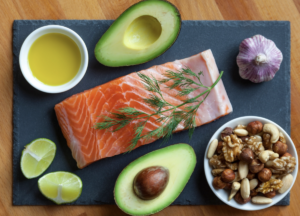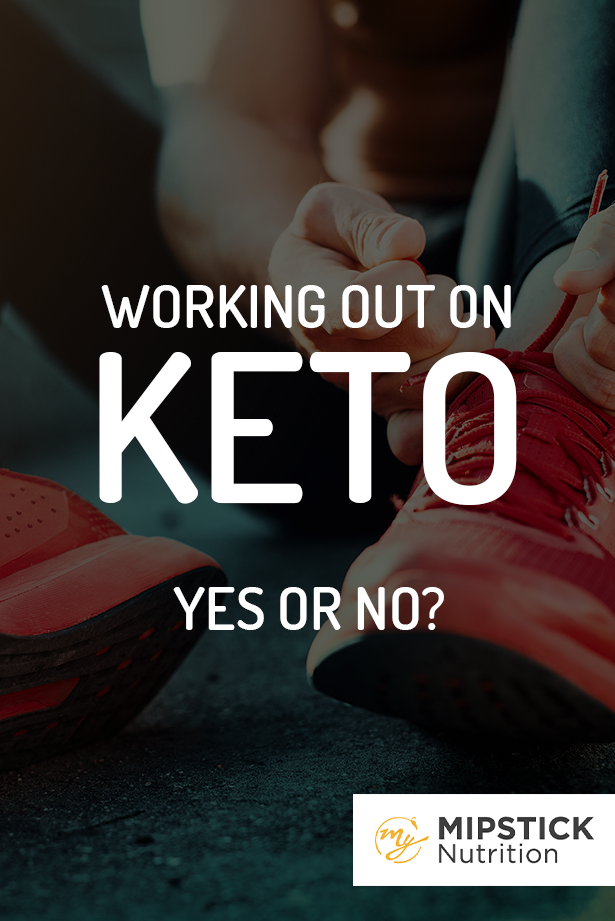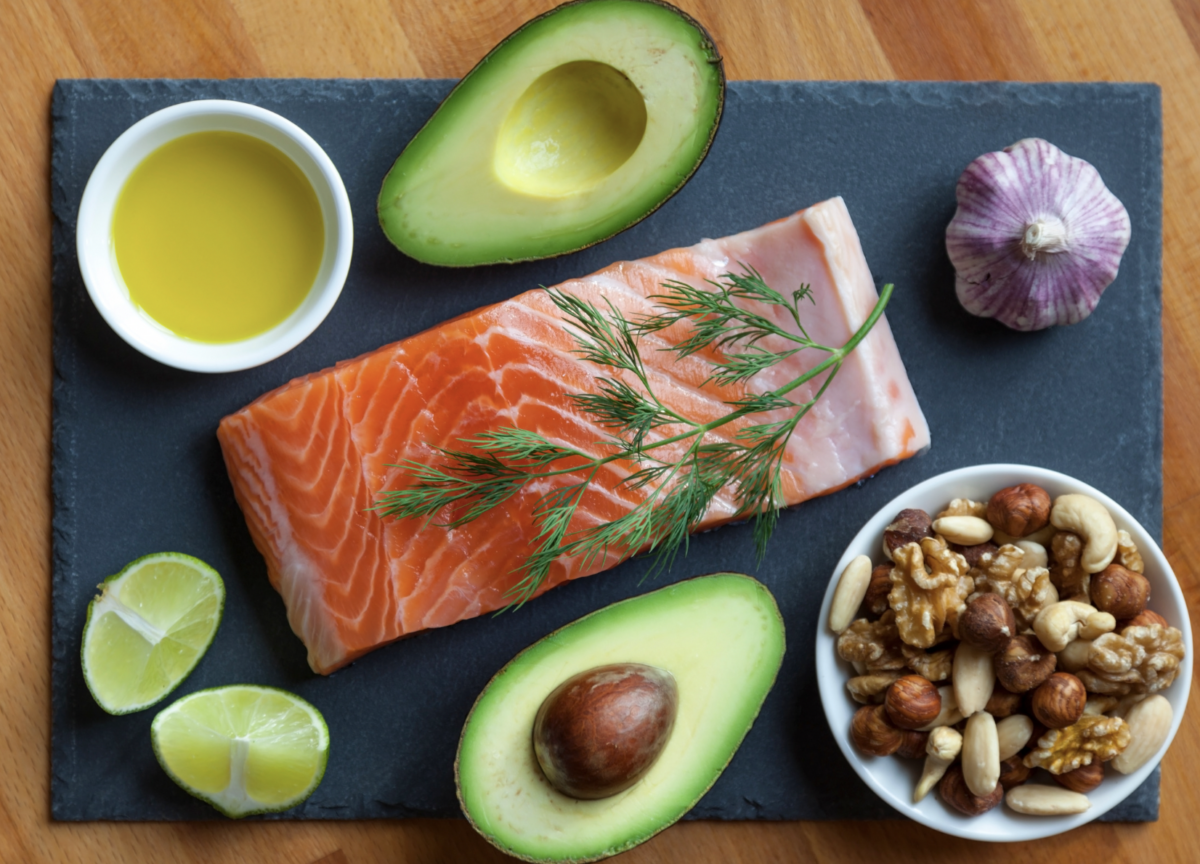April 1, 2020
The keto diet craze is here! And if you’re wondering about keto and exercise—whether you’re an athlete or not—you need to read this.
The idea behind the keto diet’s popularity is that it can literally train your body to burn fat as fuel. This means your metabolism actually changes. You stop burning carbohydrates (your body’s preferred fuel) and start burning fat (and ketones) to fuel your everyday activity.
The keto diet helps you become “fat adapted.”
How is this possible? What are the risks and benefits? And how does this apply to athletes and those who exercise?
I hash out what you need to know about keto and exercise in this post.
NOTE: Before we go on, know that the whole topic of ketosis is a hotbed of scientific research at the moment. More studies are being published regularly, so keep on the lookout for new information.
What is the ketogenic diet?
The ketogenic diet purposefully reduces carbohydrate intake and cranks up fat intake. To a very large extent!
How large?
The classic keto diet requires about 90 percent of your calorie intake to be from fat. This leaves just 10 percent for both carbohydrates and proteins. Many very healthy and nutrient-dense foods contain more than 5 or 10 percent carbohydrates (think: vegetables). And if you can’t eat a lot of vegetables, you can become deficient in many nutrients. So, this diet often comes with a recommendation to take vitamin and mineral supplements.
Also, because the level of carbohydrates needs to be so low, even the tiny amount of carbohydrates in supplements and medications needs to be monitored.
It can take 3-4 weeks of eating this way for your body to fully adapt to using fat for fuel.
But before you get too excited, this doesn’t mean that it’s a free-for-all during your eating times! Good quality whole food is still recommended in the appropriate serving sizes for your goals (we can help figure out what that is for you). However, eating within a designated time period—or an intermittent eating window—might be as beneficial as focusing on what or how much you eat.
FUN FACT: The word “ketogenic” means the ability to GENerate KETOnes.
Metabolism 101 – Carbohydrates vs. Fats (and Ketones)
The first thing to understand is that your body prefers to use carbohydrates as fuel. They are the cleanest-burning, most efficient raw material for your body to convert into energy. And this doesn’t just apply to energy for your workouts. It’s also the fuel that’s used for everything that goes on inside your body (digestion, hormone production, respiration, etc.) every day, even while at rest. Essentially, your metabolism—which is the total sum of all processes in your body—relies largely on carbohydrates to make all those things happen.
So why would you want to change it from carb-burning to fat-burning? Well, albeit sometimes there are medical reasons, people are often looking for quick weight loss. Because a ketogenic diet helps your body use fat as fuel, it can burn your stored body fat more effectively, thereby leading to improved weight loss.
But before we get into that, let’s explore how this happens in your body.
In order to change your metabolism from being carbohydrate-burning to fat-burning, you need to give it a reason to change. Although your body prefers burning carbohydrates as fuel, as humans we did in fact evolve with the ability to use a backup fuel for times of starvation (or fasting). Even when you’re fasting, you still need fuel for your brain, heart, muscles, and other critical organs to work.
So, what does your body do when there aren’t enough carbohydrates to burn as fuel? It turns to your backup fuel: fat.
The keto diet mimics the effects of starving or fasting, without actually fasting. Because your body prefers carbohydrates to fuel its vital functions, when it doesn’t receive them, it perceives it kind-of like starvation. Without those carbs (in the blood sugar from those which you’ve just eaten) or those stored in the liver or muscle (as glycogen from previously eaten carbs), your body goes to “plan B”: tapping into your stored fat to use as energy.
Not only is your body tapping into its fat stores, but when this happens it naturally produces a type of biochemical called “ketones” (or “ketone bodies”). Ketones are a by-product of fat being broken down and used as fuel in the body. This is why it’s called “ketosis.”
Normally (when not in ketosis), ketones only account for 5 percent of the energy provided to our muscles. After an overnight fast, the amount of energy your muscles get from ketones goes up to 10 percent. It can get as high as 20-50 percent after 72 hours of fasting.
Another reason why ketosis has drawn such interest lately is that it requires less oxygen to produce the same amount of energy. This makes sense if the state of ketosis is specifically for survival or starvation. Our bodies need to adapt to less food and become more efficient to be able to continue with every day tasks.
Exercise requires a lot of energy. When we’re in ketosis, our bodies become more efficient (need less oxygen to produce energy). Considering we have a much larger reserve of fat stored in our bodies than carbohydrates, tapping into those fat stores sounds like a pretty good idea for an athlete, right?
Maybe not. There’s more to it.
FOR HEALTH NERDS: When there is a lack of carbohydrates, the plasma glucose (blood sugar), hepatic glycogen, and insulin levels all drop. This stimulates lipolysis (breakdown of lipids) of fat stores, which liberates free fatty acids (FFAs) into the blood. It’s these FFAs that are the main substrate for ketogenesis (making ketones). Your liver uses them to produce acetylacetate (AcAc), which is reduced to β-hydroxybutyrate (β-HB).
The β-HB enters the mitochondria and is oxidized to acetyl-CoA for the Citric Acid cycle (TCA cycle). This produces ATP, which is the energy needed by your muscles. Because your skeletal muscles make about 40 percent of your weight, they account for the highest amount of ketone body metabolism at rest.
WHAT ABOUT PROTEIN? Let’s not forget about this macronutrient. The recommended daily amount of protein is a minimum of 12-15 percent, with most sources suggesting that this is grossly underestimated and should be closer to 20-30 percent. This is particularly true for athletes (endurance and strength) whose needs are greater due to increased protein breakdown in the body. Remember that the classic keto diet allows for only 10 percent combined carbohydrates and protein . . . so reduced carbohydrates are not the only concern for keto and exercise.

Keto and exercise – endurance athletes
Lots of athletes are curious about the ketogenic diet.
The fact is, there isn’t too much clinical research available as of now, so let’s go over what we do know, shall we?
There are three systems in which your body produces the energy that you need both for metabolic processes and for exercise:
1) The ATP-PC system which provides a very fast and powerful surge of energy that last up to 10 seconds. Adenosine triphosphate + phosphocreatine are what fuels this 10 seconds. This system would be used in a sprint or 1 rep max.
2) The anaerobic glycolytic system that quickly provides energy for a continued higher intensity 2-3 minute period. As the name suggests, carbohydrates and glycogen (stored carbohydrates) fuel this system. This system would be used in a set of 15 reps of bicep curls, or running the length of the soccer field, for example.
3) The aerobic (aka oxidative) system which provides a continual slower and more steady supply of energy from both carbohydrates and fats. This system is used in every day life and would also be used in lower intensity, longer duration exercise (i.e., easy jogging).
As you might guess, an endurance athlete training for longer durations at a lower to moderate intensity would likely get a large portion of the energy they need from the aerobic system. Note that in this system, the body is able to tap into both carbohydrates and fat to use for energy. With a ketogenic diet, there wouldn’t be adequate carbohydrates to provide energy so the body would go to “plan B” and would burn fat primarily as fuel. Good news for the endurance athlete, right?
In fact, many endurance athletes are enjoying the performance (and weight loss/management) benefits of a keto/low-carb diet. It appears that being fat-adapted can improve your body’s ability to use fats as fuel (over carbohydrates) when training in this aerobic zone.
This is not to say that all endurance athletes are making the keto switch. There’s lots more to consider, but studies are promising in this area.
Keto and exercise – strength, power, or sprint athletes
In contrast to endurance athletes, strength, power, and sprint athletes spend considerably more time in higher intensity training zones. Note that in these zones/systems, fat is not one of the sources of energy. Anaerobic means “without oxygen.” The intensity or workload of activity in these systems requires a great deal of fuel to be produced very quickly. Carbohydrates are what the body is able to breakdown and utilize for energy this quickly. It cannot do this with fats. Fats, on the other hand, take a little longer for the body to convert into energy and this process requires a good supply of oxygen (hence, the aerobic or oxidative system).
Regardless of how fat-adapted you become on a ketogenic diet, strength, power, and sprint athletes will still require carbohydrates to optimally fuel higher intensity activity.
We’re talking sprinting, weight lifting, boxing, HIIT (high intensity interval training), etc. Most studies suggest intensity levels over 65 percent of VO2 max will put the body into an anaerobic zone where carbohydrates will again become the main source of fuel. And when they’re not available for the task, or they run out, it’s known as “hitting the wall.”

Keto and exercise – athletic performance for high intensity exercise
Understanding what we do about how energy is produced biochemically in the body, we can see why a diet lacking in adequate carbohydrates would impair performance, especially at higher intensity levels.
There seems to be a lack of performance benefits for most athletes who eat low carb, high fat diets in general. In fact, at least one study has shown impaired performance during high intensity workouts.
“Benefits of ketogenic dieting for performance with a high intensity component are equivocal.” (Burke, 2015)
This may be because of how much the muscles rely on glycogen, especially during intense exercise.
As exercise intensity increases, the muscles shift from getting energy from blood fats and glucose, and rely more on muscle fat and glycogen for fuel. In fact, at moderate to high intensities, muscle glycogen becomes the main source of energy.
Here is a quote from Chang, et. al., 2017:
“There is emerging evidence that LCHF [low carbohydrate high fat] diets could be beneficial, particularly for performance in ultra-endurance sports. Their effect on field-based sports that require repeated high-intensity activities is also promising. It appears that at least several months of adaptation to a LCHF diet are required for the metabolic changes and restoration of muscle glycogen to occur.”
So, what the science says so far is that keto diet may help with endurance exercise. Especially after eating this way for several months. When it comes to high intensity workouts, some studies show promise, some show no effect, and some show impaired performance.
Are there risks to a ketogenic diet?
Like all extreme diets (yes, we consider anything that eliminates entire food groups, or in this case a macronutrient, extreme), it doesn’t come without risk. There are many potential risks to extreme diets, but here are a few to consider.
Firstly, quality should always be first and foremost in any diet. Whether it’s protein, carbs, or fats, eating quality sources that are rich in nutrients that your body needs is top priority.
Whole food sources of carbohydrates like sweet potato, minimally processed grains or legumes, and fresh fruit and vegetables are inherently more healthful (and supportive to your athletic goals) than any highly processed, sodium, or preservative-laden bacon or hot dogs! If you embark on a keto diet, be sure your fat intake is in the form of anti-inflammatory whole food sources like wild fish and fish oils, avocado, and raw nuts and seeds, including chia, hemp and flax. Avoid poor quality fatty foods.
Likewise, eliminating or greatly reducing nutrient-dense whole foods of any kind (carbs, fats, or protein foods) can lead to nutrient deficiencies. There are many vitamins, minerals, antioxidants, and fibre that you may be missing out on when eliminating carbohydrates.
We’ve said it before: The best diet is one you can stick to!
Compliance with any diet (or way of eating) is significantly improved when it is realistic and practical for real life. Like other strict diets that eliminate many common foods, the keto diet can be very difficult to adhere to and often lead to a rebound effect that can be just as detrimental to weight loss or exercise performance goals than the diet itself.
To minimize the risk of muscle breakdown (yes, the body often breaks down stored protein/muscle to use as energy when carbohydrate stores are low), ensure at least 1.3 to 2.5 g/kg of protein daily.
Have you heard about all the science showing how important our healthy gut bacteria to numerous areas of health? Autoimmunity, neurological conditions, hormone imbalances, etc. are linked to gut function—specifically our gut flora or bacteria. Guess what these healthy gut bugs eat? If you guessed carbohydrates, you are correct. The implications of a keto diet to our gut flora, and therefore to many aspects of our wellbeing, are unknown. “Some research notes that the keto diet could damage the concentration and composition of your gut bacteria.” More research is needed.
Who should avoid ketogenic diets?
Yes, the ketogenic diet is strict and can be difficult to maintain. Plus, there are many conditions that it can aggravate. Particularly metabolic conditions like:
- primary carnitine deficiency
- carnitine palmitoyl transferase deficiencies
- carnitine translocase deficiency
- beta-oxidation defects
- pyruvate carboxylase deficiency
- acyl dehydrogenase deficiency
- hydroxyacyl-coenzyme A deficiency
- porphyria
If you have any of the above metabolic conditions, don’t “go keto.”
The ketogenic diet can also have side effects in people without any of those conditions. The most common one—constipation—affects between 14-46 percent of people.
Other side effects include:
- Lethargy
- Metabolic abnormalities (e.g., dehydration, hypoglycemia, excessive ketosis, metabolic acidosis, and electrolyte imbalance)
- Gastrointestinal side effects (e.g., nausea, vomiting, and rarely hepatitis or pancreatitis)
- Kidney stones
- Growth failure and vitamin/mineral deficiencies and their outcomes (including low bone density and increased fractures)
- Heart and blood fat issues like cholesterol (interestingly, these blood fat issues seem to return to normal after people stop the keto diet)
So this is why people on medically-recommended ketone diets, such as children with epilepsy, should be monitored regularly.
Alright now, knowing what you know, if you decide a ketogenic diet might work for you, here’s what we’ve learned about how to start.

How to get into ketosis
There are two ways to get your body into ketosis.
The first is by eating a ketogenic diet. There are a few different ways you can do this that I cover below.
The second way to get into ketosis is by using ketogenic supplements. These are fairly new to the market, and research is limited right now. I will give you the scoop on what we actually do know about these.
Eating a ketogenic diet
There is the classic ketogenic diet and modified ketogenic diets.
The Classic Ketogenic Diet
As mentioned earlier, the classic keto diet is composed of about 90 percent of your calories from fat and just 10 percent for both carbohydrates and proteins.
Some people have medical reasons why they have to eat a ketogenic diet. For example, certain metabolic disorders like “glucose transporter 1 deficiency syndrome” or “pyruvate dehydrogenase deficiency.”
Another reason why people “go keto” is to help with drug-resistant epilepsy. Some studies show that seizures can reduce up to 50 percent in some children. The children on the classic keto diet need to be closely monitored to minimize side effects and ensure they’re getting enough nutrition to grow properly.
For everyone else, it’s pretty optional and seems to be popular for the quick weight loss it often renders.
Modified Ketogenic Diets
There are three modifications to the classic keto diet that make it easier to maintain the state of ketosis. By easier, I mean they require less than 90 percent of the daily calories to be from fat.
The first is the Medium-Chain Triglyceride Diet (MCTD). This modification allows 73 percent of calories from fat. However, it is mandatory to include a specific kind of fat called medium-chain triglycerides. This is because your liver actually makes ketones directly from these special fats. The MCTD recommends that MCTs make up about half of the fats ingested. This means that if you don’t use pure MCT oil, coconut oil would be your main daily fat source.
The second modification to the ketogenic diet is called the Modified Atkins Diet (MAD). This allows 65 percent of calories from fat, as long as the carbohydrate intake stays below 5 percent of calories. This means the remaining 30 percent would be protein.
The third modification is the Low Glycemic Index Diet (LGID). This one targets 60 percent of the calories from fat. Because it allows a higher intake of carbohydrates, the carbohydrates eaten must be low glycemic (which means they have little impact on your blood sugar).
So there are your four standard ways to “go keto” with diet: Classic, Medium-Chain Triglyceride Diet (MCTD), Modified Atkins (MAD), and Low Glycemic Index Diet (LGID).
Keto supplementation
Forget the keto diets; Can I just take a supplement?
Actually . . . technically, yes.
The ketones your body produces internally are endogenous ketones. As you recall, these ketones are produced by the liver from the fats in the blood.
Keto supplements are exogenous ketones because they’re not made by the body. These exogenous ketones help your body get into the state of metabolic ketosis, without the restrictive diet.
They are in the form of β-hydroxybutyrate salts (β-HB) or ketone esters and they produce ketosis for 0.5-6 hours. The esters are often buffered with a mineral salt such as sodium, potassium, or calcium.
After taking a ketone supplement (usually a powder to be mixed with water), it quickly increases your blood ketone levels. This happens despite levels of blood sugar, glycogen, or insulin. In other words, you don’t have to restrict carbohydrates to increase your blood levels of ketones with these supplements.
These exogenous ketones are broken down and absorbed by the gut. They get into the bloodstream and go to the liver to be metabolized.
Some of the reported side effects of ketone ester supplementation are flatulence, nausea, diarrhea, and dizziness.
Ketogenic supplements for athletes
There is a difference between ketosis from a keto diet and ketosis from a supplement—especially if you exercise. The main difference is that, with the supplements, there would still be sugar and insulin in the blood, and glycogen in the muscles. This is a good thing for the athlete who depends on that carbohydrate to fuel exercise and ensure performance is not hindered.
Ketosis from supplements does a few things:
- Allows muscles to keep their glycogen stores
- Decreases lactate concentrations
- Increases fat oxidation
And they seem to do this even if you take them along with a carbohydrate supplement.
Ketone supplements show improved energy efficiency (more energy with less oxygen needed). Well, at least they do in rat hearts. However, the question remains whether this is the same for human skeletal muscle during exercise. And if it is, does this translate to more power for the same amount of oxygen consumed (i.e., improved muscle efficiency)?
We just don’t know for sure just yet.
One recent study in Cell Metabolism looked at two groups of cyclists who supplemented with optimal levels of carbohydrates. Some of them also incorporated a ketone supplement, and others had just the carbohydrates. The group who supplemented with both showed a small improvement in performance. They were able to go 2 percent farther (400 m) on average than those who only supplemented with carbs.
So, there may be some benefit to aerobic competitions when supplementing with both ketones and carbohydrates. Particularly in highly trained endurance athletes. But, this was just one small study, so more research is definitely needed.
As I mentioned earlier, there is not a lot of research just yet on the effects of keto and exercise.
“Although ketone body supplementation has been proposed to be beneficial for endurance athletes and ketone esters are speculated to be routinely used by professional cyclists, to the best of our knowledge there is currently limited information on the effects of ketone body supplementation on exercise metabolism and performance in recreational and/or elite athletes . . . . In conclusion, based upon the few available data and our current understanding of ketone body metabolism during exercise in a sports specific setting, we conclude there is currently no evidence to support the use of ketone bodies as an ergogenic aid under conditions where optimal evidence based nutritional strategies are applied.” (Pinckaers, 2017)
So, the bottom line with keto supplements is that they may help exercise performance, but we really don’t know. More research is needed.
Keto and Exercise Take Away For Today
Keto and exercise may or may not work well together. The diet craze is here, and it may (or may not) be for you. Educating yourself and evaluating your goals are essential if you’re considering this diet.
There are several ways to get into the state of metabolic ketosis. One is with the classic keto diet, or one of the three modifications you can try. And, of course, there are also ketone supplements that can get you there for up to 6 hours.
The keto diet is not without risks, though. Because it is restrictive, it can result in metabolic symptoms, gastrointestinal issues, as well as nutritional deficiencies, to name a few.
As for athletes, if you’re an endurance athlete, a ketogenic diet may be beneficial. As for high-intensity, the study results really are a mixed bag.
“Unless you’re an ultra-endurance athlete, becoming fat-adapted or adopting a ketogenic diet probably won’t improve your performance.” (Precision Nutrition)
And when it comes to keto supplementation, there is a lot of speculation, and little evidence.
“Our current understanding of ketone body kinetics during exercise is insufficient to warrant their use as an ergogenic aid in any practical sports setting.” (Pinckaers, 2017)
More research is needed (and is underway).
WONDERING WHAT WE THINK ABOUT KETO AND EXERCISE AT BUILD?
For now, what we do know is that our bodies prefer good quality carbohydrates to fuel our everyday activity and certainly our athletic performance. Fundamentally, we believe the bigger question we should all be asking ourselves is: What are the right kinds of foods (and all macronutrients) and how much of each do our bodies need to be their bests?
Wanna chat more about meeting your nutritional needs?
Get in touch today!
We love hearing from you 😁
References
Burke, L. M. (2015). Re-Examining High-Fat Diets for Sports Performance: Did We Call the “Nail in the Coffin” Too Soon? Sports Medicine (Auckland, N.z.), 45(Suppl 1), 33–49. http://doi.org/10.1007/s40279-015-0393-9
LINK: https://www.ncbi.nlm.nih.gov/pmc/articles/PMC4672014/
Chang, C. K., Borer, K., & Lin, P. J. (2017). Low-Carbohydrate-High-Fat Diet: Can it Help Exercise Performance? Journal of Human Kinetics, 56, 81–92. http://doi.org/10.1515/hukin-2017-0025
LINK: https://www.ncbi.nlm.nih.gov/pmc/articles/PMC5384055/
Cox, P. J., Kirk, T., Ashmore, T., Willerton, K., Evans, R., Smith, A., Murray, A. J., Stubbs, B., West, J., McLure, S. W., King, M. T., Dodd, M. S., Holloway, C., Neubauer, S., Drawer, S., Veech, R. L., Griffin, J. L., & Clarke, K. (2016). Nutritional Ketosis Alters Fuel Preference and Thereby Endurance Performance in Athletes. Cell Metabolism. 24(2), p256–268. doi: 10.1016/j.cmet.2016.07.010.
LINK: https://www.cell.com/cell-metabolism/fulltext/S1550-4131(16)30355-2
Cox, P. J. & Clarke K. (2014). Acute nutritional ketosis: implications for exercise performance and metabolism. Extreme physiology & medicine. 3(1), 1. http://doi.org/10.1186/2046-7648-3-17
LINK: https://www.ncbi.nlm.nih.gov/pmc/articles/PMC4212585/
Evans, M., Cogan, K. E., & Egan B. (2017). Metabolism of ketone bodies during exercise and training: physiological basis for exogenous supplementation. Journal of Physiology. 595(9), 2857-2871. doi: 10.111
LINK: https://www.researchgate.net/profile/Brendan_Egan2/publication/309885871_Metabolism_of_ketone_bodies_during_exercise_
Healthline. (2019, July 12). Keto and gut health. Retrieved from https://www.healthline.com/nutrition/keto-and-gut-health
Luat, A. F., Coyle, L. & Kamat, D. (2016). The Ketogenic Diet: A Practical Guide for Pediatricians. Pediatr Ann. 45(12):e446-e450. doi: 10.3928/19382359-20161109-01.
LINK: http://www.healio.com/pediatrics/journals/pedann/2016-12-45-12/%7Bc18fc6b4-746f-446b-8f6c-9cdc046eed9e%7D/the-ketogenic-diet-a-practical-guide-for-pediatricians
Martin, K., Jackson, C. F., Levy, R. G., & Cooper, P. N. (2016). Ketogenic and other dietary treatments for epilepsy. Cochrane.
LINK: http://www.cochrane.org/CD001903/EPILEPSY_ketogenic-and-other-dietary-treatments-epilepsy
Pinckaers, P. J. M., Churchward-Venne, T. A., Bailey, D., & van Loon, L. J. C. (2017). Ketone Bodies and Exercise Performance: The Next Magic Bullet or Merely Hype? Sports Medicine (Auckland, N.z.), 47(3), 383–391. http://doi.org/10.1007/s40279-016-0577-y
LINK: https://www.ncbi.nlm.nih.gov/pmc/articles/PMC5309297/
Precision Nutrition. (n.d.). The Ketogenic Diet: Does it live up to the hype? Retrieved from http://www.precisionnutrition.com/ketogenic-diet
Schoeler, N. E. & Cross, J. H. (2016). Ketogenic dietary therapies in adults with epilepsy: a practical guide. Pract Neurol. 16(3):208-14. doi: 10.1136/practneurol-2015-001288.
LINK: http://pn.bmj.com/content/16/3/208.long
Volek, J. S., Noakes, T. & Phinney, S. D. (2015). Rethinking fat as a fuel for endurance exercise. European Journal of Sport Science. 15(1), 13-20. doi: 10.1080/17461391.2014.959564.
LINK: http://www.tandfonline.com/doi/full/10.1080/17461391.2014.959564
Volek, J. S., et al. (2016). Metabolic characteristics of keto-adapted ultra-endurance runners. Metabolism. 65(3), Pages 100–110.
LINK: http://www.metabolismjournal.com/article/S0026-0495(15)00334-0/fulltext
Leave a comment for us below, we appreciate your feedback!


Do keto and exercise go together? Here’s what you need to know
The entire contents of this website are based upon the opinions of Build Holistic Nutrition. Please note that Build Nutrition is not a dietitian, physician, pharmacist or other licensed healthcare professional. The information on this website is NOT intended as medical advice, nor is it intended to replace the care of a qualified health care professional. This content is not intended to diagnose or treat any diseases. Always consult with your primary care physician or licensed healthcare provider for all diagnosis and treatment of any diseases or conditions, for medications or medical advice, as well as before changing your health care regimen.
© BUILD NUTRITION 2026. ALL RIGHTS RESERVED. PRIVACY POLICY
Go ahead, creep us on social. You know you want to!
